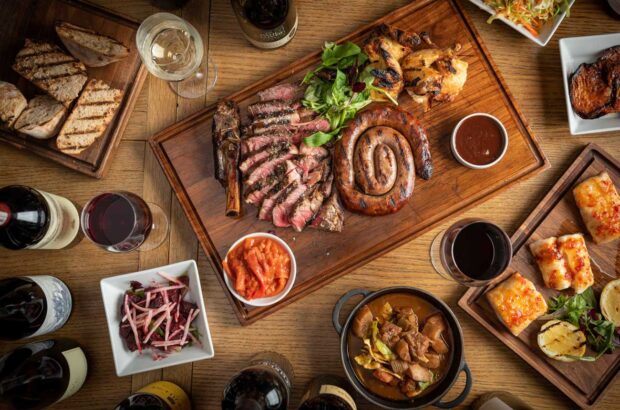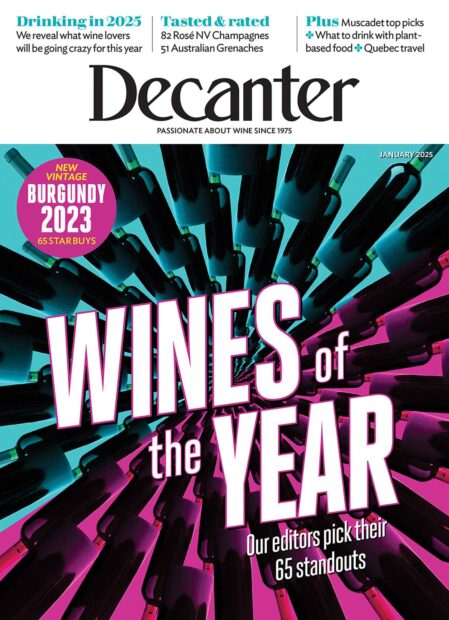Andrew Jefford heads for the little-known Rhône village of Gadagne.
Châteauneuf du Pape, the huge 3,200-ha appellation everyone knows about, lies about 17 km to the north of Avignon, and its most famous vineyard soil type is the giant rolled pebbles deposited by the wandering Rhône during the Villafranchian age, around two to three million years ago.
It’s not, though, the only Châteauneuf near Avignon. If you head not north but east out of the city for about 14 km, you will come to Châteauneuf de Gadagne, and there (to your probable amazement) you will find a much smaller zone of around 180 ha of vineyards planted exclusively on giant rolled pebbles — also deposited by the wandering Rhône during the Villafranchian age, around two to three million years ago. I use the same words because the similarity (and shared origins) of these two vineyard types is so striking.
Gadagne was included in the Côtes du Rhône zone back in 1937, and in the general Villages appellation in 1997. Its history, vineyards and the potential quality of its wine, though, merited more than that: named village and perhaps, one day, cru status. Why not climb the ladder?
Alas, problems lay in wait: the growers of Châteauneuf du Pape were implacably opposed to anyone else using the name Châteauneuf. This struck the growers of Châteauneuf de Gadagne as unfair. Originally a woodcutter’s village, building of the ‘new castle’ to which its name makes allusion began in 1150; the village’s name then (at the time it was a Provençale-speaking seigneurie lying outside both France and the Papal lands) was Castèu-Nòu-la-Destrau – a destrau being the Provençale word for an axe. Châteauneuf du Pape at that stage was known as Châteauneuf Calcernier, after its limestone quarry. It had been a ‘Châteauneuf’ (castrum novum) since 1094 or earlier, though the actual ‘Châteauneuf du Pape’, whose ruins dominate the appellation today, was only begun in 1317.
It therefore struck the Gadagne growers that their particular ‘new château’ was the older of the two, and that they had every right to use the village’s full, official name for their wine. There are, moreover, a series of old boundary stones marking the limits of the papal domains to be found in some of the Gadagne vineyards. The village’s Provençale credentials are second to none, since it was in Gadagne’s Ch de Fontségugne in 1854 that the Provençale poet Frédéric Mistral and friends founded the Félibrige, to preserve and promote Provençale language and culture.
The stand-off between the two Avignon rivals lasted ten years. In the end the lead negotiator for the Gadagne growers, the energetic Xavier Anglès of Domaine du Bois de St Jean, realised that the forces ranged against them were overwhelming, and that the dispute would prevent them ever achieving named village status, so they capitulated. Gadagne tout court became one of the 18 named villages in 2012.
I toured the appellation with almost all of its growers towards the end of last month. There aren’t many of them – just seven in total (six individual producers plus the Terres d’Avignon cooperative, now fused with the Canteperdrix cooperative in Ventoux to form Demazet Vignobles). I saw the papal boundary stones; I stumbled about on the giant boulders (which the vines love, but which are hard on growers’ ankles, tyres and the steel blades of ploughs); I noted all the windbreaks, since the Mistral blows as strongly here as it does a little further north. And I tasted.
The appellation rules (in contrast to those of Châteauneuf du Pape) require blends, and cover red wines only at present, though at least one producer, former abdominal surgeon Robert Janer at Clos des Saumanes, is convinced that white wines can be outstanding here too. Because most of the wines sell at around 10 euros or so, some growers machine harvest, and yields are in general a little higher than they would be for leading domains in Châteauneuf du Pape.
But, make no mistake, these are wines of powerful personality, with a force, an energy and an intensity to them that you will not often find among their peers in the ‘named village’ division. They are very distinctively southern, too, with powerfully spicy notes. I can’t say that they rival top Châteauneuf du Pape yet, because they don’t: the textural wealth is not the same, and growers need to work more on gentleness of articulation, middle-palate mass and subtlety of nuance. If anything, the wines are a little too forceful at present, as if the quality of the pebble-over-clay vineyards was shouting too loudly and almost needed subduing. But the potential is exciting. For Rhône-lovers, Gadagne (with or without its Châteauneuf) is worth noting.
Tasting Gadagne
I tasted most of the growers’ 2015 vintage efforts recently, and some earlier vintage wines last year.
Domaine du Bois de St Jean, Cuvée de Comte d’Ust et du St Empire, Côtes du Rhône Villages Gadagne 2015
Vincent and Xavier Anglès Domaine du Bois de St Jean is based in Gadagne’s neighbouring village of Jonquerettes. Between 2003 and 2012, the brothers extended the domain with the purchase of 4.5 ha in Vacqueyras and a half hectare in Châteauneuf du Pape itself. The Gadagne cuvée is principally Syrah – yet the soils here give it a marked red-fruit character (cherries and chocolate) with a saline, herb-strewn complexity: very pure, very sustained, very intense, marked by the drama of the vintage. 90
Domaine du Bois de St Jean, Cuvée de Comte d’Ust et du St Empire, Côtes du Rhône Villages Gadagne 2014
The 2014 version of this cuvee has more of a strawberry character with lots of tangy, stony warmth in a soft, open-pored style. 88
Domaine de la Chapelle, Tradition, Côtes du Rhône Villages Gadagne 2015
Sylvain and Céline Boussier look after this historic 8-ha property, formerly part of the village’s grandest estate, once in Jesuit ownership. The Tradition is a blend of Grenache and Syrah with 10 per cent each of Mourvèdre and Cinsault. The aromas are pure creamy strawberry while the palate is lighter in style than some of its village peers, but very intense, almost electric: a cascade of garrigue herbs and root spice lends those strawberry notes rigour and drive. 90
Domaine de la Chapelle, Tradition, Côtes du Rhône Villages Gadagne 2014
The 2014 vintage shares a clear stylistic kinship with the 2015: clear in colour, soft and open in style, with some floral and red fruit notes in both aroma and mid-palate, then tightening toward a more austere, bitter-herb end. 88
Ch de Fontségugne, Côtes du Rhône Villages Gadagne, 2015
This historic property is tucked snugly away in a spring-filled hollow in the lee of the Mistral. It has 4 ha of fine old-vine hillside vineyards classified as Gadagne among its 22 ha total, producing a single cuvée, from hand-harvested Grenache and Syrah. This as-yet-unbottled wine has sweet strawberry and thyme scents, with delicate bittersweet flavours: lots of sweet strawberry fruit again, but a cascade of root spice too, and some firm supporting tannins. [89]
Ch de Fontségugne, Côtes du Rhône Villages Gadagne 2012
Clear red in colour, with cherry fruit and some savoury notes, too. Smooth, tangy flavours with sweet fruit balanced by firm tannins and a chocolate finish. 86
Domaine des Garriguettes, Fontisson, Côtes du Rhône Villages Gadagne, 2015
Sébastien Clément’s organic domain has produced a very dark, Syrah-dominant wine in 2015. There is some reduction initially, but this lifts after a while to reveal a dense, tight-knit, amply constituted wine packed with salty-stony primary fruits. The effect is a little wild at present, but with time this wine may settle down and reveal its inner resources in more harmonious form. 89
Domaine des Pentelines, Flavour, Côtes du Rhône Villages Gadagne 2015
Bertrand Hardy’s organically certified domain occupies a superb, unitary 28-ha hillside site of which 17 ha falls into the Gadagne AOC. The 2015 Flavour cuvée (€7.80 from the domain) is a blend of 60 per cent Grenache with Syrah, Mourvèdre and Carignan is ample, rich and relatively generously textured for its price, with ample extract and dry-fruit tenacity. 89
Domaine des Pentelines, Select, Côtes du Rhône Villages Gadagne 2012
The 2012 Select also includes a small percentage of old-vine Carignan, giving the wine a faintly acidic edge rather than the strawberry-like sweetness of some of its peers. There are some bitter-cherry notes here, too, and again its style puts extract to the fore: definitely a food wine. 88
Domaine de Quilex, Demazet Vignobles, Côtes du Rhône Villages Gadagne 2013
The co-operative owns around half the planted land in the appellation, including the 11-ha Domaine de Quilex, its prestige Gadagne, a blend of 60% Grenache and 40% Syrah. The 2013 vintage was a difficult one for Grenache, and the wine has aged relatively swiftly, with mushroom and saucisson notes on the aroma and soft, open flavours in which the classic root spice of Gadagne is apparent. 86
Domaine de Quilex, Demazet Vignobles, Côtes du Rhône Villages Gadagne 2012
The 2012 Quilex is not complex, but its voluminous, sweet and soft southern fruits, robed in a little chocolate, were showing exceptionally attractively when I tasted this wine last year; there’s liquorice to finish, too. 88
Clos de Saumanes, Côtes du Rhône Villages Gadagne 2015
Martine and Robert Janer arrived at this 24-ha property from Troyes in 2008, having spent a year and a half looking for a suitable domain to restore (the former name was Domaine Deforge). The 2015, a blend of Grenache, Syrah and Mourvèdre crafted by winemaker Matthieu Wild, has rich plum-bramble scents and a primary black-fruit style on the palate, too: deep, chunky and chewy, with the distinctive Gadagne spicy finish. 91
Clos de Saumanes, Côtes du Rhône Villages Gadagne 2012
Deeply coloured, with ripe, earthy black-fruit scents. The palate is generously ripe, with lots of spice and a pu-erh tea note, too. Low acidity and soft tannins give it a soft, plush feel. 88







